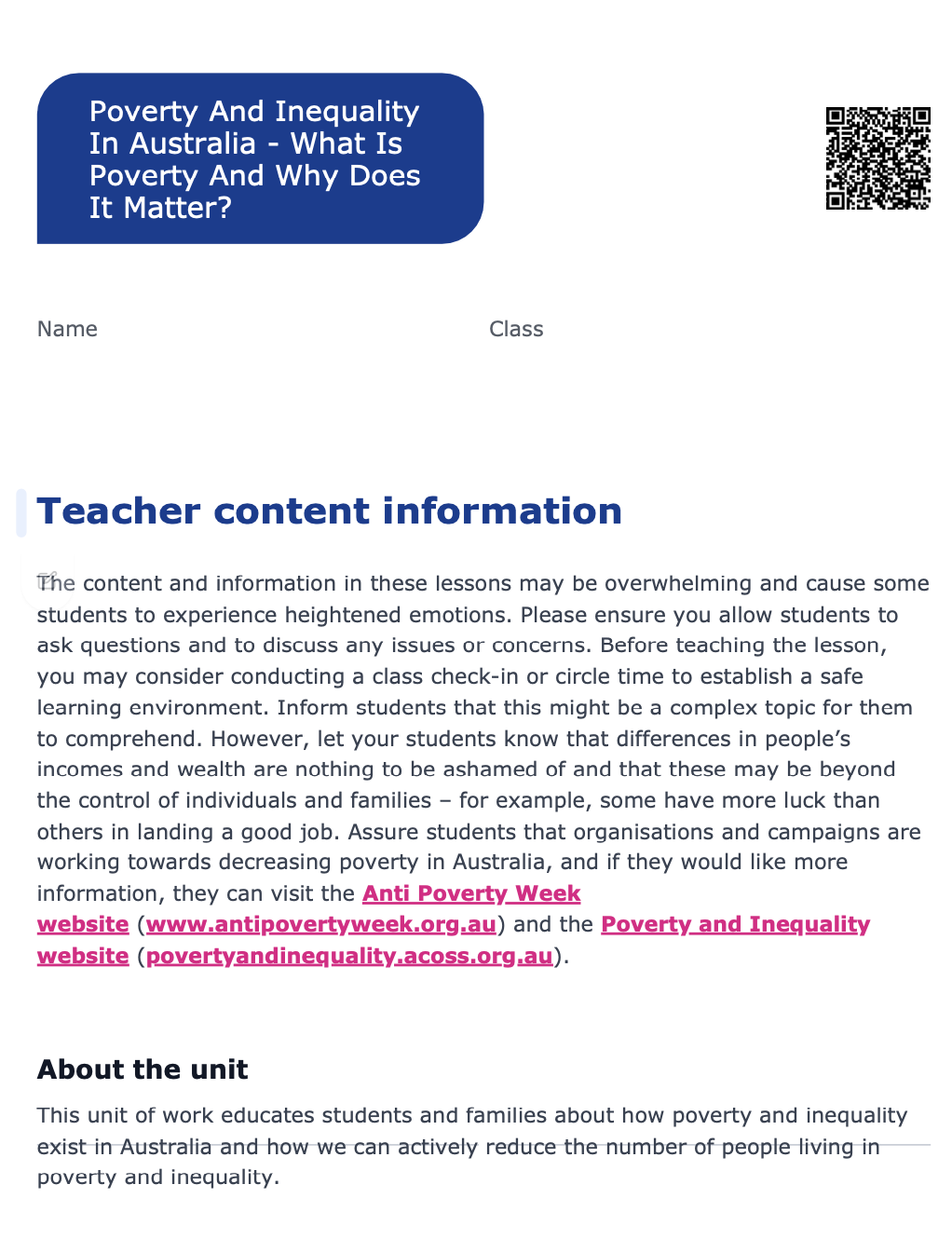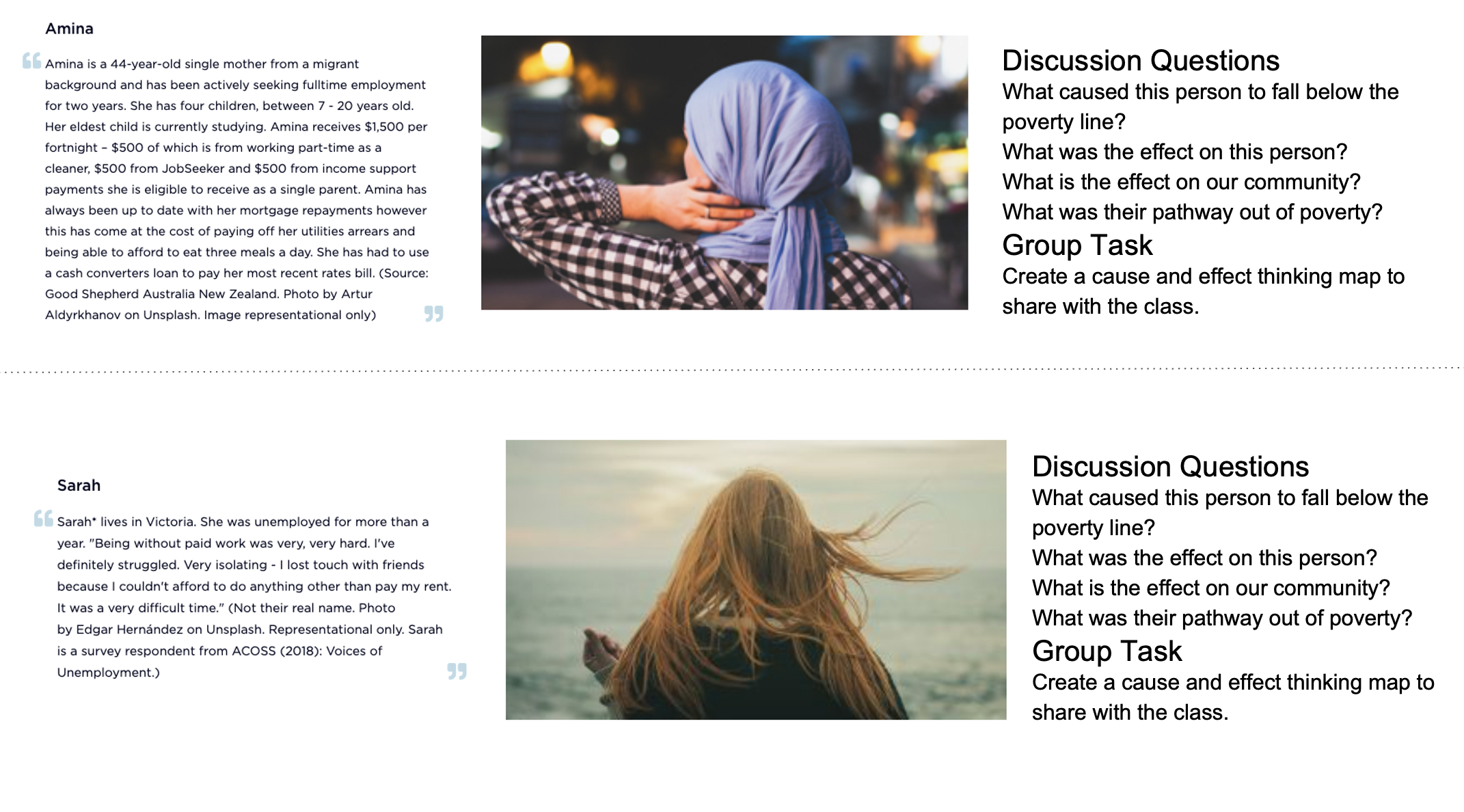Lesson summary
This lesson presents students with some basic facts and figures regarding what poverty in Australia looks like and how a range of people may experience it. It will also introduce the number and percentage of people, such as children, who live in poverty, as well as some solutions that would reduce poverty. In small teams, students discuss their ideas about the likely or possible impacts of poverty on different people in the community. They then use elements of the persuasive text to structure and compose an orally delivered argument for reducing poverty in Australian communities.
Learning intentions:
Students will...
- understand what poverty is in Australia
- investigate the cause and effects of poverty and the impact on the community
- learn about the importance of social action.
Success criteria:
Students can...
- articulate factual discoveries about poverty in Australia
- evaluate the cause and effect of poverty and pathways out of poverty
- create awareness about the number and percentage of Australians who live below the poverty line.
Lesson guides and printables
Curriculum links
Select your curriculum from the options below.
Lesson details
Skills
This lesson is designed to build students’ competencies in the following skills:
- communication
- critical thinking
- empathy
- ethical understanding
- global citizenship
- problem solving
Curriculum Mapping
Australian curriculum content descriptions:
Year 3 English:
- Listen to and contribute to conversations and discussions to share information and ideas and negotiate in collaborative situations (ACELY1676)
- Plan and deliver short presentations, providing some key details in logical sequence (ACELY1677)
Year 4 English:
- Interpret ideas and information in spoken texts and listen for key points in order to carry out tasks and use the information to share and extend ideas and information (ACELY1687)
- Plan, rehearse and deliver presentations incorporating learned content and taking into account the particular purposes and audiences (ACELY1689)
Syllabus outcomes: EN2-4A, EN2-2A, EN2-7B, EN2-9B, EN2-12E
General capabilities: Literacy, Creative and Critical Thinking, Ethical Understanding
Relevant parts of Year 3 achievement standards:
By the end of Year 3, students understand how language can be used to express feelings and opinions on topics. They contribute actively to class and group discussions, asking questions and providing useful feedback and making presentations, and they create a range of texts for familiar and unfamiliar audiences.
Relevant parts of Year 4 achievement standards:
By the end of Year 4, students understand how to express an opinion based on information in a text. They contribute actively to class and group discussions, varying language according to context and they use language features to create coherence and add detail to their texts. Students create structured texts to explain ideas to different audiences.
UN Sustainable Development Goals
UN SDG 1: End poverty in all its forms everywhere
- Target: 1.1: By 2030, eradicate extreme poverty for all people everywhere, currently measured as people living on less than $1.25 a day.
- Target: 1.1: By 2030, ensure that all men and women, in particular the poor and the vulnerable, have equal rights to economic resources, as well as access to basic services, ownership and control over land and other forms of property, inheritance, natural resources, appropriate new technology and financial services, including microfinance.
Resources Required
- A device capable of presenting video, data and a PowerPoint to the class
- Community Cards and Questions – (to be cut out and given out to each group)
- PowerPoint presentation: The Facts about Poverty in Australia (provided)
Additional Info
Time required: 110 mins
Level of teacher scaffolding: Medium – present introductory PowerPoint; organise small group discussions and facilitate a whole-class discussion
These lessons have been designed in consultation with Anti-Poverty Week and ACOSS/UNSW Poverty and Inequality Partnership.
The content and information in these lessons may be overwhelming and cause some students to experience heightened emotions.
Please ensure you allow students to ask questions and to discuss any issues or concerns. Before teaching the lesson, you may consider conducting a class check-in or circle time to establish a safe learning environment. Inform students that this might be a complex topic for them to comprehend. However, let your students know that differences in people’s incomes and wealth are nothing to be ashamed of and that these may be beyond the control of individuals and families – for example, some have more luck than others in landing a good job.
Assure students that organisations and campaigns are working towards decreasing poverty in Australia, and if they would like more information, they can visit the Anti Poverty Week website and the Poverty and Inequality website.





Welcome back!
Don't have an account yet?
Log in with:
Create your free Cool.org account.
Many of our resources are free, with an option to upgrade to Cool+ for premium content.
Already have an account?
Sign up with:
By signing up you accept Cool.org's Terms and Conditions(Opens in new tab) and Privacy Policy(Opens in new tab).